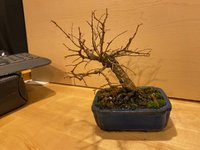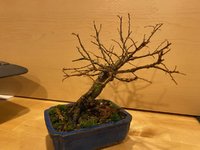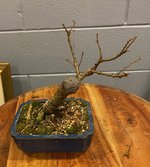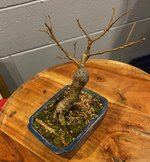LeftHandLuke
Shohin
I'm inexperienced with shohin-sized trees and could use some advice on what this guy needs in the way of trimming and/or wiring to set him up for next season. I get the feeling that there are some obvious "Bonsai 101" techniques that I'm overlooking but haven't been able to see the forest for the trees, so to speak. Hopefully you can tell what direction I'm headed from the pics. Sorry for not including any size references... It's about seven inches from bench to highest branch. Winter pics were taken this morning. Autumn pic was taken Oct. 18. I let him grow freely last summer and gave him a haircut about halfway through. Now with the branches bare, is there anything that needs addressed? There's a bit of a reverse-taper blob at the top of the trunk where all the branches originate. I think that's inevitable and would be hidden by the canopy. Should the branches be thinned out and/or cropped back? Any other observations? Thanks in advance.













